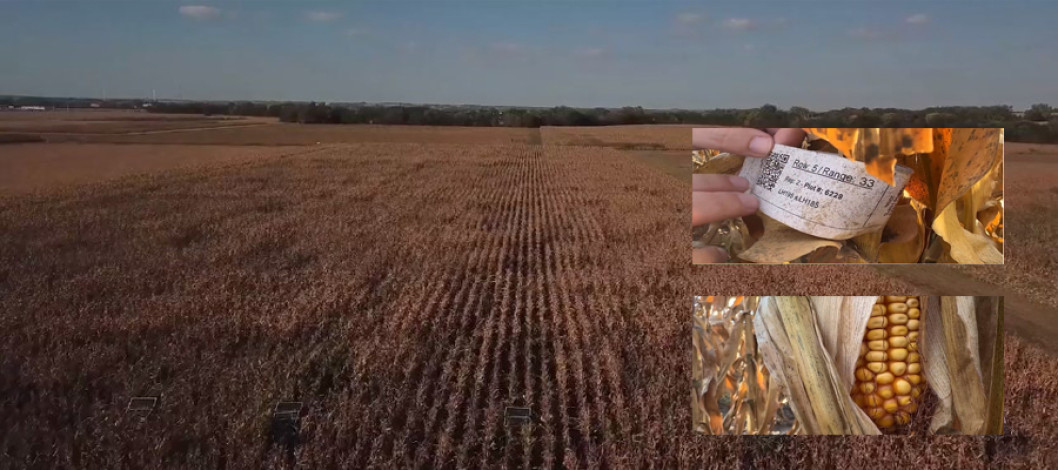
Photo Collected
An aerial view of a cornfield on the outskirts of Lincoln, Neb., is a view of the future Researchers have done what seemed impossible a decade ago: complete the sequencing of the entire maize genome.
"If you ask any farmer, I think they will tell you the three things they care about are yield, yield, and yield, and that is not going to change. That's going to be the primary focus,” says James Schnable, Gardner Professor of Agronomy at the University of Nebraska- Lincoln.
In order to help boost yields, Schnable first had to finish a job started back in 2007 at Iowa State University.
“They got a draft of the easy parts of the corn genome that was published in 2009, but that left a lot of complex, repetitive parts of the genome that just are hard to put together,” he says.
That work was actually spearheaded by Schnable’s father, Patrick Schanble, C.F. Curtiss Distinguished Professor at Iowa State University.
James Schnable says he collaborated with researchers at Iowa State, but the idea was led by a team at the China Agricultural University.
Missing Pieces of a Giant Puzzle
He describes mapping the corn genome as like putting together the sky in a puzzle. The pieces all look the same, and you have to figure out which ones are missing, and where they all go.
“The most difficult part was a lot of those holes are just the same piece, or the same DNA sequence, repeated over and over and over again. That's why I like this analogy of putting together a puzzle. If you just have the same-colored puzzle piece over and over and over again, all you can do is try one after another, which pieces fit into the other. And that's really what we had to do to fill in some of those biggest holes,” says Schnabel.
The latest technology, allowed the researchers to sequence much longer pieces of DNA. And with that, they discovered the missing pieces, allowing them to conquer a major feat: to map the entire corn genome.
“When the first version of the corn genome was sequenced, individual DNA sequences that we could read were only maybe 1,000 to 2,000 letters long. Now we're able to sequence pieces 20,000, 30,000, or 40,000 base pairs long, which is why we were able to successfully fill in with all those last missing holes,” he explains.
With the latest DNA sequencing technologies, along with genetic and physical maps, the team then got to work sequencing the corn genome, with the goal of answering lingering questions about corn.
“We still do not have good technologies for figuring out which corn hybrids are going to perform in which environments without actually testing them. We need to be doing a better job of this because the Nebraska 2040, or the Nebraska 2030, is very different from Nebraska 2023. And we need to be developing corn hybrids today that are going to thrive in farmers' fields and the Nebraska 2030,” says Schnabel.
Allows Researchers to Make Better Decisions Early On
Schnable says knowing the entire sequence equips researchers with better decision-making tools.
“The difference is we can make better decisions early on about which varieties have promise and which ones should be moving through that pipeline -- based not on how the plants are performing in the field today but on how we think the plants will perform in the fields of 2030 when there's going to be less nitrogen, less water and different growing seasons than the ones that we are working with today,” says Schnabel.
The team then tracks those corn plants across a research field just outside of Lincoln, but they also have research fields across Nebraska and Iowa. Schnable says this allows the team to discover which genes control performance in a wide range of soils and environments.
“But as long as we can keep increasing yield, the two big questions that come beyond that are drought tolerance and the ability to use water more efficiently. And similarly, the ability to use nitrogen more efficiently,” he adds.
The Secrets from Sorghum
The team didn’t just map the corn genome, but also sorghum. So, which one was simpler to do? Schnable says it was definitely sorghum.
“Sorghum is a lot easier, as it is about a third of the size of the corn genome. It has a lot less of this repetitive stuff. That was why it was so hard to finish the corn genome,” Schnabel says.
Knowing the entire sequence of both the sorghum and corn genome, Schnable says it now allows researchers to harvest even more answers.
“What sorghum has the corn doesn't is an ability to grow in much more marginal environments. It grows with less water and with less nitrogen. Sorghum doesn't have as much yield potential as corn, but it can tolerate a lot more stress,” he says.
See details.
Source:
Online/GFMM
Comment Now